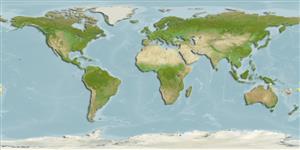klasifikasi / Names
Nama-nama umum | Sinonim (persamaan) | Catalog of Fishes(Marga, Jenis) | ITIS | CoL | WoRMS | Cloffa
>
Pleuronectiformes (Flatfishes) >
Soleidae (Soles)
Etymology: Aseraggodes: Greek, aggos, -eos, -ous = vessel, uterus, carapace of a crab + Greek, aseros, -a, -on = to remove the appetite (Ref. 45335); magnoculus: Name from Latin words 'magnus' for large and 'oculus' for eye, referring to its having the largest eyes (relative to the head length) among the species in this genus.
More on author: Randall.
Environment: milieu / climate zone / depth range / distribution range
Ekologi
laut berasosiasi dengan karang; kisaran kedalaman 3 - 18 m (Ref. 57560). Tropical
Western Central Pacific: New Caledonia.
Size / Weight / umur
Maturity: Lm ? range ? - ? cm
Max length : 4.0 cm SL jantan/; (Ref. 57560)
deskripsi pendek
Kunci identifiaksi (pengenalan) | Morfologi | Morfometrik
duri punggung lunak (Keseluruhan (total)) : 67 - 72; Sirip dubur lunak: 51 - 53; vertebrata, bertulang belakang: 36. Diagnosis: Dorsal rays 67-72; anal rays 51-53; dorsal rays branched except anterior 16-24 rays; anal rays branched. Lateral-line scales 71-76, including 7-8 anterior to a vertical at upper end of gill opening. Vertebrae 36; dorsal pterygiophores anterior to fourth neural spine 10. Body depth 2.45-2.5 in SL; head length (HL) 4.15-4.3 in SL; eye diameter 3.95-4.2 in HL upper eye overlapping about anterior one-third to one-half of lower eye; interorbital space narrow, the vertical distance separating eyes about one-third to one-sixth eye diameter. Caudal peduncle absent. Very fine cirri on ventral edge of head. Lateral line aligned with ventral edge of upper eye. Longest dorsal ray 1.4-1.45 in HL; caudal fin rounded, its length 3.9-3.95 in SL; pelvic fins 1.8-2.0 in HL; the tip of the longest ray reaching base of second or third anal ray. Ocular side in alcohol light yellowish brown with 3 rows of dark brown blotches, one row below base of dorsal fin, one above base of anal and pelvic fins, and one with two largest blotches well-spaced on lateral line; other brown markings mainly vertically elongate, some enclosing small irregular areas of ground color; fins pale yellowish except for faint dark blotches along base (Ref. 57560).
Collected from a steep slope of a fringing reef, with coral rock, rubble and sand at base (Ref. 57560).
Life cycle and mating behavior
Kematangan | Reproduksi, perkembang biakan | Pemijahan | telur-telur | Fecundity | Larva
Randall, J.E., 2005. A review of soles of the genus Aseraggodes from the South Pacific, with descriptions of seven new species and a diagnosis of Synclidopus. Memoirs of Museum Victoria 62(2):191-212. (Ref. 57560)
Status IUCN Red List (Ref. 130435: Version 2024-2)
ancaman kepada manusia
Harmless
penggunaan manusia
Alat, peralatan
laporan khas
muat turun XML
Sumber internet
Estimates based on models
Preferred temperature (Ref.
123201): 24.7 - 28.8, mean 26.4 °C (based on 200 cells).
Phylogenetic diversity index (Ref.
82804): PD
50 = 0.5000 [Uniqueness, from 0.5 = low to 2.0 = high].
Bayesian length-weight: a=0.00977 (0.00466 - 0.02049), b=3.07 (2.90 - 3.24), in cm total length, based on LWR estimates for this (Sub)family-body shape (Ref.
93245).
Trophic level (Ref.
69278): 3.3 ±0.5 se; based on size and trophs of closest relatives
Daya lenting (Ref.
120179): Tinggi, Waktu penggandaan populasi minimum kurang dari 15 bulan (Preliminary K or Fecundity.).
Fishing Vulnerability (Ref.
59153): Low vulnerability (10 of 100).
